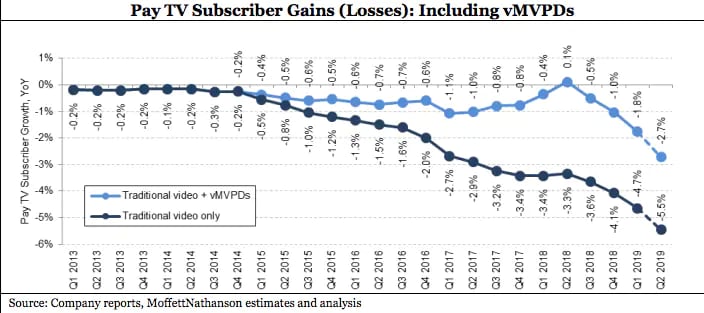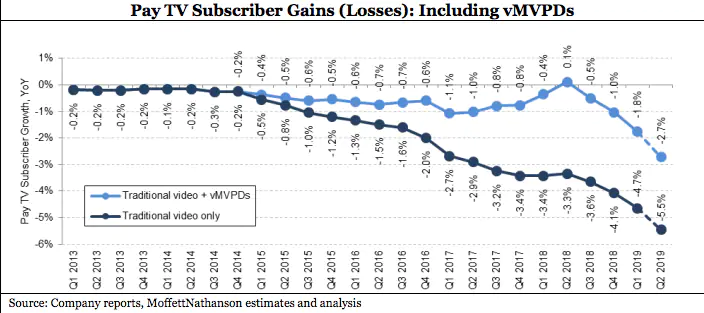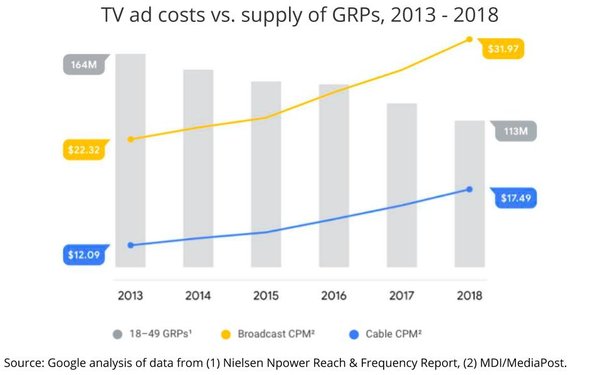Traditional marketing is broken because it requires brands to create content with a short shelf-life to run on platforms they don't own or control that depreciate in value over time. On top of that, the costs to do this remain as high as ever. We've coined a term for this dubious cycle of diminishing returns - The Marketing Poverty Trap.
This article breaks down the 4 main reasons why traditional marketing is broken and shows marketers and brands how they can break out of the marketing poverty trap by creating content that lives forever and investing in assets they own that appreciate over time.
1. You Must Invest In Platforms You Don't Own on Control
Decades ago, if you were an aspiring creator, you'd have to get picked by someone else to share your art or your work with the world.
If you were a musician, you'd have to get picked by a record label. If you were an author, you'd have to get picked by a publishing company.
Fortunately, the internet has democratized the communications channels and significantly reduced the barriers to entry for artists, entrepreneurs and creators all over the world.
Now anyone can create their work or their art and share it through YouTube, social media or a blog. There's no longer a gatekeeper between the creator and its audience.
You have no influence over how the platform evolves. You have no stake in the value of the platform appreciating over time. And you have to pay any time you want to leverage it.
For some reason, businesses have been slow to adjust to this new reality, especially from a marketing perspective. So many of us have been stuck channeling our reach through platforms we don't own or control like TV or radio stations, magazines or billboard companies.
While traditionally these vehicles have been successful in helping brands amplify their reach, the brands themselves don't own or control these platforms.
When a marketing and advertising strategy is rooted in platforms your business doesn't own or control, you're needlessly giving up too much:
- You have no influence over how that platform grows or evolves.
- You have no stake in the value of the platform appreciating over time.
- You still have to pay money any time you want to leverage it.
2. Traditional Media Channels are Constantly Depreciating in Value
As a society we are consuming more content and media than ever before in the history of humanity. But there's also more options available to us than ever before.
When my father was growing up, there were only a handful of TV stations and radio stations. There was 1 local newspaper and a handful of national and regional papers. So the entire population was divided up into large audience segments between these relatively few media channels.
The rate of media expansion has significantly outpaced population growth. So competition for attention has exploded and the audiences for each platform have become significantly more fragmented.
Now, there are hundreds of cable TV channels. Dozens of local terrestrial radio stations. Streaming services. YouTube channels. Social media apps. Podcasts. Blogs.
Anyone can access just about any channel or media type they want from anywhere in the world. The rate of media expansion has significantly outpaced population growth.
So competition for attention has exploded and the audiences for each platform have become significantly fragmented. Just take a look at the evolution of cable TV subscribers in recent years:

 Sourced From: The Wrap
Sourced From: The Wrap
We've seen newspapers and magazines go under. And if trends continue, traditional TV and radio stations will eventually meet the same fate. But for now, one thing is clear: When a platform's audience continues to shrink, its value to marketers becomes increasingly less valuable.
3. However, It's Still Really Expensive
You could certainly find some examples of cost reduction for advertising spots on traditional media like radio and television. But the fact remains that cost of advertising on traditional media has not kept pace with the total reductions in audience size. The average CPM (cost per 1,000 impressions) has actually increased in most cases.
 Sourced From: Media Post
Sourced From: Media Post
As audiences decrease and some advertisers move away from these platforms, the only way for these companies to continue to turn a profit is to keep advertising costs high - disproportionate to the value they're offering marketers and brands.
Traditional media has a lot of overhead. Satellites. Technology. Production talent. On-air talent. Office buildings and physical infrastructure. And huge teams of sales representatives and corporate decision-makers.
So as audiences decrease and some advertisers move away from these platforms, the only way for these companies to continue to turn a profit is to keep advertising costs high - disproportionate to the value they're offering marketers and brands.
4. Your Content Has an Expiration Date
When you create content to advertise on traditional media, in most cases that content is only as good for as long as it runs on that platform. Not to mention, most ads are designed to promote time-specific offers that need to be rotated in and out frequently.
By exclusively developing platform-specific content, marketers and brands become stuck in a habit of creating assets that can only exist effectively for a period of weeks or months.
Contrast this with publishing content on your blog, podcast, YouTube channel or social media accounts. In these scenarios you can publish articles, images, videos and long-format audio files that can live and be discovered by search engines forever.
Not to mention, you don't have to constantly pay a media platform to keep those pieces of content available and visible to the public.
By exclusively developing platform-specific content, marketers and brands become stuck in a habit of creating assets that can only exist effectively for a period of weeks or months. They completely forfeit the opportunity to develop content that can live forever and constantly help them grow their audiences and influence more people.
Understanding the Marketing Poverty Trap
To recap, traditional marketing is broken, because it entraps marketers and brands in an endless cycle of depreciating returns. Here's how it works:
- Business develops content with a short shelf-life (platform-specific content).
- To run on a platform it doesn't own or control (radio, TV, billboards, etc.).
- That depreciates in value over time (fragmentation, shrinking audiences).
- While constantly paying just as much or more for a diminishing result (costs remain high).
We've coined a term for this dubious cycle, The Marketing Poverty Trap.
According to Investopedia:
A poverty trap is created when an economic system requires a significant amount of capital in order to earn enough to escape poverty. When individuals lack this capital, they may also find it difficult to acquire it, creating a self-reinforcing cycle of poverty.
The simple fact that traditional advertising is already expensive - at least to do it effectively - prevents many small businesses from entering the space to begin with.
On top of that, its model of diminishing returns is pushing brands who are already invested in it slowly out of the space.
Traditional marketing can still work in some cases, but for any brand to anchor its growth strategy in platforms it doesn't own or control with steadily shrinking audiences would be a mistake.
It's no wonder many people believe marketing does work. But of course, marketing does work. There is an alternative to the Marketing Poverty Trap.
Breaking Free of the Marketing Poverty Trap
Freeing your business and its growth trajectory from the endless depreciation of an exclusively-traditional marketing strategy is relatively simple:
1. Create Content That Lives Forever
Start a podcast. Maintain a blog. Produce video content in a variety of formats. Publish this content on your website or other platforms that can live forever and be indexed by search engines.
2. Invest in Platforms or Assets You Own Or Control
There are many platforms you own - or at least have significantly more control over - that won't require you to pay somebody any time you want to engage its audience. They include, but are not limited to, the following:
- Your website
- Your blog
- Your YouTube channel
- Your social media accounts
- Your CRM (email distribution list)
- Your podcast
3. Grow YOUR Audiences
When you create your own content on a regular basis, you give people a legitimate reason to follow you. So use your content to grow the amount of people who subscribe to your blog, podcast or YouTube channel.
Grow the amount of people in your email distribution list. And the people who follow you on social media. Doing all of that will also likely help your website rank higher on search engines, thus increasing website traffic and enabling each of your other audiences to continue to grow as well.
4. Audit and Optimize Conversion Paths
Producing valuable content at a high frequency over time is sure to increase website traffic and grow your sphere of influence - from your email subscribers to your social media followers and everything in between.
But the size of your audiences by themselves are just vanity metrics without a specific strategy for converting them into leads and customers for your business.
What is the goal of having someone subscribe to your email list? After someone follows you on social media, what is the next logical step for them to deepen their level of engagement with your brand?
Map out paths for each platform or content type and create a strategy to add value, offer deeper levels of engagement and convert members of your audience to leads and customers over time.
5. Pay to Accelerate Results
Of course, running ads on third-party platforms can still work, provided your marketing and growth strategy isn't anchored in that.
Once you develop a scalable, sustainable ecosystem of content and owned or controlled platforms, you can advertise on other platforms to amplify your brand, generate more leads and grow your audience(s). In addition to traditional media, this can also include paid search, paid social, website retargeting and other ad campaigns.
Creating Scalable, Sustainable Growth
It's much easier to grow more efficiently and more sustainable when you create content that can live forever and invest in platforms you own or control.
The Gist is a full-service inbound marketing and growth agency that's perfectly-equipped to help you break free of the Marketing Poverty Trap and create scalable, sustainable methods for growing your business. Schedule an exploratory call if you're interested in discussing this further.